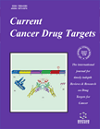- Home
- A-Z Publications
- Current Cancer Drug Targets
- Previous Issues
- Volume 13, Issue 9, 2013
Current Cancer Drug Targets - Volume 13, Issue 9, 2013
Volume 13, Issue 9, 2013
-
-
Unveiling the Role of Nuclear Transport in Epithelial-to-Mesenchymal Transition
More LessEpithelial-to-Mesenchymal transition (EMT) is a phenomenon in which cancer cells loose their polarity, undergo morphological changes from epithelial to mesenchymal thereby achieving plasticity that confers an invasive and metastatic behavior. A large number of signaling molecules (Wnt/β-Catenin, TGF-β, notch, EGF, HGF and hypoxia) have been implicated in the EMT process. The EMT signaling molecules are localize Read More
-
-
-
Roles of Epithelial-Mesenchymal Transition in Cancer Drug Resistance
More LessAuthors: Yulong Shang, Xiqiang Cai and Daiming FanOvercoming intrinsic and acquired drug resistance is a major challenge in treating cancer. Poor responses to drug treatment can result in metastasis, cancer dissemination and death. Recently, the epithelial-mesenchymal transition (EMT) has been found to play a critical role in cancer drug resistance, but the nature of this intrinsic link remains unclear. This review summarizes recent advances in the understanding of dr Read More
-
-
-
Regulation of Mesenchymal Phenotype by MicroRNAs in Cancer
More LessAuthors: Jinchun Yan, Kiranmai Gumireddy, Anping Li and Qihong HuangEpithelial-mesenchymal transition (EMT) is a developmental process that converts epithelial cells into migratory and invasive cells. This process also plays an important role in cancer progression and metastasis by enabling tumor cells to leave primary sites. EMT is regulated by complex transcription networks and post-transcriptional modulators. MicroRNAs are single-stranded non-coding RNAs that represent a novel clas Read More
-
-
-
MicroRNAs as Critical Regulators Involved in Regulating Epithelial- Mesenchymal Transition
More LessAuthors: Xiaodi Zhao, Yuanyuan Lu, Yongzhan Nie and Daiming FanThe epithelial-mesenchymal transition (EMT) is a fundamental biological process that is involved in normal embryogenesis, would healing, and tissue repair, as well as numerous pathologies, including organ fibrosis, malignant transformation, and cancer progression. Both transcriptional and post-transcriptional regulatory mechanisms contribute to a complex and tightly controlled regulatory network during the EMT process, a Read More
-
-
-
Emerging Role of Mucins in Epithelial to Mesenchymal Transition
More LessEpithelial to mesenchymal transition (EMT) is an important and complex phenomenon that determines the aggressiveness of cancer cells. The morphological transformation of cancerous cells is accompanied by various cellular processes such as alterations in cell-cell adhesion, cell matrix degradation, down regulation of epithelial marker Ecadherin and upregulation of mesenchymal markers N-cadherin and Vimentin. Besid Read More
-
-
-
Regulation of EMT by Notch Signaling Pathway in Tumor Progression
More LessAuthors: Yumei Li, Jia Ma, Xiujuan Qian, Qiong Wu, Jun Xia, Lucio Miele, Fazlul H. Sarkar and Zhiwei WangNotch signaling pathway has been reported to play critical roles in the development and progression of human cancers because Notch signaling pathway is critically involved in many cellular processes including cell proliferation, survival, apoptosis, migration, invasion, angiogenesis, and metastasis. Emerging evidence suggests that Notch regulates EMT (Epithelial-to-Mesenchymal Transition), leading to tumor invasion and Read More
-
-
-
The Role of Snail in EMT and Tumorigenesis
More LessAuthors: Yifan Wang, Jian Shi, Kequn Chai, Xuhua Ying and Binhua P. ZhouEpithelial-mesenchymal transition (EMT) is a highly conserved process in which polarized, immobile epithelial cells lose tight junctions, associated adherence, and become migratory mesenchymal cells. Several transcription factors, including the Snail/Slug family, Twist, δEF1/ZEB1, SIP1/ZEB2 and E12/E47 respond to microenvironmental stimuli and function as molecular switches for the EMT program. Snail is a zinc-finger trans Read More
-
-
-
Epigenetic Regulation of Epithelial to Mesenchymal Transition
More LessAuthors: Peiwei Huangyang and Yongfeng ShangEpithelial-mesenchymal transition (EMT) is a vital process implemented in embryo development, organ fibrosis, and cancer metastasis. Several transcription factors and signaling pathways impinge on the transcriptional program of the cell, leading to the change of cell phenotype without alteration of genotype. Accumulating evidence suggests that epigenetic mechanisms play important roles in inducing EMT and orchestra Read More
-
-
-
Regulation of EMT by KLF4 in Gastrointestinal Cancer
More LessAuthors: Jiujie Cui, Min Shi, Ming Quan and Keping XieGastrointestinal (GI) cancer is characterized by its aggressiveness, but the underlying mechanism is not fully understood. Studies reveal that epithelial to mesenchymal transition (EMT), which is regulated by a series of transcription factors and signaling pathways, is strongly associated with GI cancer cell proliferation, invasion and metastasis. Importantly, EMT is a product of crosstalk between signaling pathways. Kruppe Read More
-
-
-
Decoding the Knots of Initiation of Oncogenic Epithelial-Mesenchymal Transition in Tumor Progression
More LessAuthors: Pengda Guo, Aidi Gao, Gaochuan Zhang, Hongyan Han and Quansheng ZhouOncogenic epithelial-mesenchymal transition (oncEMT) plays important roles in the genesis of cancer stem cells (CSCs), malignant tumor initiation and progression, cancer metastasis, and drug resistance. Although the role of oncEMT in tumorigenesis has recently been extensively studied, the initiation of oncEMT is not clearly understood, and its mechanisms of action are still unknown. Emerging evidence suggests that oncEMT Read More
-
Volumes & issues
-
Volume 25 (2025)
-
Volume 24 (2024)
-
Volume 23 (2023)
-
Volume 22 (2022)
-
Volume 21 (2021)
-
Volume 20 (2020)
-
Volume 19 (2019)
-
Volume 18 (2018)
-
Volume 17 (2017)
-
Volume 16 (2016)
-
Volume 15 (2015)
-
Volume 14 (2014)
-
Volume 13 (2013)
-
Volume 12 (2012)
-
Volume 11 (2011)
-
Volume 10 (2010)
-
Volume 9 (2009)
-
Volume 8 (2008)
-
Volume 7 (2007)
-
Volume 6 (2006)
-
Volume 5 (2005)
-
Volume 4 (2004)
-
Volume 3 (2003)
-
Volume 2 (2002)
-
Volume 1 (2001)
Most Read This Month
Article
content/journals/ccdt
Journal
10
5
false
en


